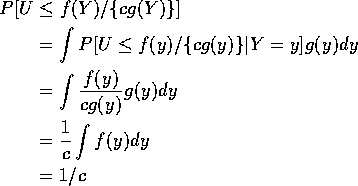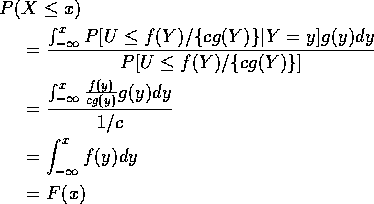STAT 380 Lecture 25
Inverse (Probability Integral) Transform
Fact: F continuous CDF and X,U satisfy
![]()
then ![]() Uniform(0,1) if and only if
Uniform(0,1) if and only if ![]() .
.
Proof: For simplicity: assume F strictly increasing on inverval (a,b) with F(b)=1 and F(a)=0.
If ![]() Uniform(0,1) then
Uniform(0,1) then

Conversely: if ![]() and 0 < u < 1 then
there is a unique x such that F(x) = u
and 0 < u < 1 then
there is a unique x such that F(x) = u

Application: generate U and solve F(X)=U for X
to get ![]() which has cdf F.
which has cdf F.
Example: For the exponential distribution
![]()
Set F(X) = U and solve to get
![]()
Observation: ![]() so
so ![]() also has
an Exponential(
also has
an Exponential( ![]() ) distribution.
) distribution.
Example: : for F the standard normal cdf solving
![]()
requires numerical approximation but such solutions are built in to many languages.
Special purpose transformations:
Example: : If X and Y are iid N(0,1) define
![]() and
and ![]() by
by
![]()
NOTE: Book says
![]()
but this takes values in ![]() ; notation
; notation
![]()
means angle ![]() in
in ![]() so that
so that
![]()
Then
![]()
is part of circle of radius ![]() . (Start at
. (Start at ![]() and go clockwise
to angle
and go clockwise
to angle ![]() .)
.)
Compute joint cdf of ![]() at
at ![]() .
.
Define
![]()
Then

Do integral in polar co-ordinates to get
![]()
The ![]() integral just gives
integral just gives
![]()
The r integral then gives
![]()
So
![]()
Product of two cdfs so:
R and ![]() are independent.
are independent.
Moreover
![]() has cdf
has cdf
![]()
which is Exponential with rate 1/2.
![]() is Uniform
is Uniform ![]() .
.
So: generate ![]() iid Uniform(0,1).
iid Uniform(0,1).
Define
![]()
and
![]()
Put
![]()
You have generated two independent N(0,1) variables.
Acceptance Rejection
If F(X)=U difficult to solve (eg F hard to compute) sometimes use acceptance rejection.
Goal: generate ![]() where
where ![]() .
.
Tactic: find density g and constant c such that
![]()
and s.t. can generate Y from density g.
Algorithm:
Facts:

so
![]()
Most important fact: ![]() :
:
Proof: this is like the old craps example:
We compute
![]()
(condition on the first iteration where the condition is met).
Condition on Y to get

as desired.